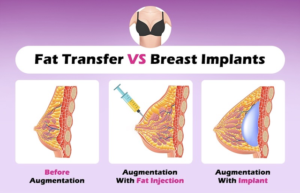Breast Augmentation vs. Fat Transfer Surgery
Voluptuous, beautiful, perky, and perfectly round breasts are the rage since 1962, and having a breast augmentation has remained the most requested cosmetic enhancement ever since. Skilled and qualified plastic surgeons performed nearly 300,000 breast enlargement procedures, with 85% being silicone and 15% saline implants, according to the American Society of Plastic Surgeons 2019 Annual Statistics Report. One reason is the advancement of the implants available with many types of style options available.
A lesser-known alternative that has become on-trend over the last ten years is the natural breast surgery called a fat transfer for those who prefer organic breast augmentation. Before choosing which is suitable for you, let’s examine the plus and minuses of each to see which procedure is ideal for you and your expectations.

Who Is a Good Candidate for a Fat Transfer?
• People with extra fat to transfer from other parts of the body such as arms, stomach, back, hips, neck, and waist.
• If your implants are way too big, no longer match your body, or are hanging off your body. These are possible factors to consider a fat transfer.
• Silicone or Saline implants aren’t ideal for you.
• Individuals who have weight gain and then lost weight or previously breastfed are ideal candidates because there is now extra skin to alleviate skin tension.
Who Isn’t a Good Candidate for a Fat Transfer?
• Did you go too big with your implants? If you want to remove your silicone or saline implants for a more natural option and have large implants, then you will need an ample supply of fat equivalent in volume of your implants to be successful. Also understanding, the breast pronunciation isn’t going to be the same as with an implant.
• Thin or fit individuals who have 2% or less viable fat are not great candidates. You are wasting your time with the fat transfer procedure.
• If your chest is flat, results will be minimal because there is no place for the fat to go. You can have the fat grafting procedure, but your expectations need to be realistic. You won’t get more than one cup size bigger.
What is Fat Transfer and How Is the Surgery Performed?
• Fat grafting uses your available body fat in places where you don’t want it and injects it into an area you do, like your breasts.
• No, you can’t use another person’s fat (one of the most asked questions.); the body recognizes it as a foreign substance and go into fight mode and rejects it.
• Fat transfer is two procedures in one.
o First,locating the parts of your body to harvest the fat. Dr. Barrett will need at least 200 to 500 ccs, depending on the volume required for your breasts to have a reasonable outcome. Dr. Barrett practices a safe technique that doesn’t use energy-assisted liposuction with a laser that can burn your fat cells. He uses tiny cannulas (thin tube) to transfer the fat to eliminate big oil cysts or significant fat accumulation.
o Second,taking the harvested fat, process it, then delicately transfer it to the breast. The breast tissue is like a sponge, so each fat droplet is carefully situated in its own section. The fat can’t be placed in one area, or it won’t spread out evenly.
• Fat cells need to have space, not be under pressure or traumatized from harvesting. They need oxygen, nutrients from a good blood supply, so compressing the breast after the operation isn’t done.
Breast Implants vs. Fat Grating What to Expect
• As Dr. Barrett expresses it, “Implants are extremely reliable in terms of shape, form, and projection.” You will know the result without any surprises. A 350cc implant will be the same size ten years from now.
• An implant will give you a 2-3 cup size improvement.
• Implants are associated with complications. It can rupture, get capsule contracture, and not fitting for people with autoimmune problems.
• Sometimes it will take up to three times transferring fat to get the desired result because the breast can only expand so far.
• Expect about a half of a cup size improvement from fat grafting.
• The result with fat grafting is unknown because it depends on your body’s resorption rate. You also lose 30% to 50% of the volume in about three months. Once that happens, then you will see the results.
• Good quality fat with meticulous placement will provide the best result.

The reasons for not getting implants vary from fear (which is understandable because choosing the wrong plastic surgeon can give a horrible breast result with your breast augmentation) to not wanting to put something foreign in the body. Dr. Barrett is a board-certified, well-respected plastic surgeon located in Beverly Hills who has perfected natural-looking breast implant augmentation. For many people, fat transfer to the breast is the right option when seeking restorative volume. It requires dedication and meticulous attention to detail, the professional traits Barrett Plastic Surgery is known for in Los Angeles.
If you’re ready for more information about the pros and cons of breast implants versus fat transfer, contact Barrett Plastic Surgery at 310-598-2648 to schedule a consultation. If you’re more content speaking with our team from the comfort of your home, we provide virtual surgical consultations.
Do you want to learn more about Barrett Plastic Surgery? Stay current by subscribing to our blog and following us on social media at Twitter, TikTok, Instagram, Realself, YouTube, Snapchat, Yelp, and Facebook for updates.
Thank you for visiting!




0